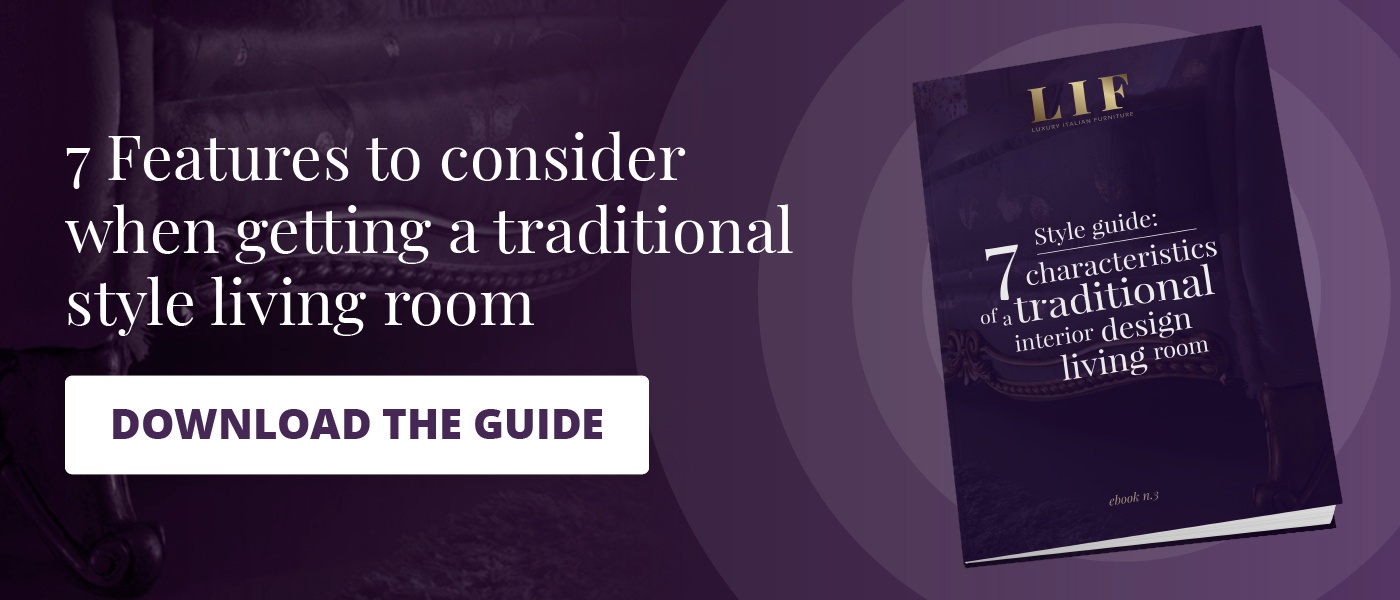In any variation, classical style expresses a careful search for perfection, attention to detail and a love of elegance. Every room in the house needs its own atmosphere, a distinctive aesthetic hallmark that will express your preferences when it comes to decorating and furnishings.
If you want to create a refined furnishing layout, inspired by classic style, then first of all, you need to draw up a detailed list of classic furnishing styles for living rooms that can suit this area of your home.
This article will take a look at the living room, analysing the different furnishing concepts devised to give a classy look to this specific area of the home. The ideal way to make a style statement.
- Classic living room elements
- 10 Furniture styles that will never go out of fashion
- Classic interiors: how to furnish your living room with elegance and personality
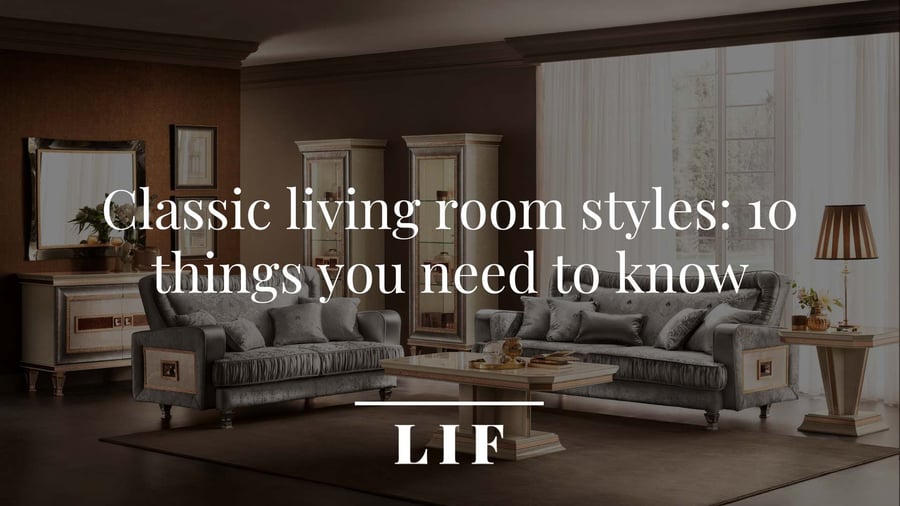
Classic living room elements
Classic style takes the aesthetic canons of noble houses of the past, pervaded by luxury, refinement and attention to detail, and brings them up to date with our times, preserving that aura of timeless elegance that makes classic furniture immune to passing trends and fads.
The common thread that binds past and present together is quality, expressed on several levels and dominating every element of a classic interior: from finishes - always precious and refined - to fine upholstery and furnishing materials, passing through the accessories that help to recreate the sophisticated and luxurious atmosphere that permeates classic-style environments.
Of these, the colour palette used for walls, accessories, decorations and fabrics plays an important role.
The right balance for a classic-style living room involves a combination of soft, tasteful colours, such as white, ivory, dove grey and the beige scale, and warmer, deeper tones, such as those of dark woods, and/or inserts that recall the expression of luxury, such as marble surfaces and gold and bronze finishes.
However, classical style does not have a unique identity. Many influences have passed through it over the centuries, transforming it into what we know today: a varied and dynamic style, a way of furnishing rich in nuances and different atmospheres.
10 Furniture styles that will never go out of fashion
In order to create a living room that fully reflects the multifaceted spirit of classic style, we must retrace its history and the stylistic evolutions that have brought it to the present day.
We have identified 10 tips. Let's find out!
1. Renaissance
The first furnishing items with a perfect renaissance aesthetic were made in Italy in the 15th century. Furniture that complies with the canons of this style can be recognized for their strong architectural sense and notable dramatic presence.
In general, renaissance style furnishing elements present decorative features that are carved into the surface of the wood (walnut or chestnut), such as columns, pediments, and cornices, but they also have precious decorative features, like the detailing in gold leaf, that create a perfect pairing with the deep tones of the walnut finishes and match the linear designs of each item with their imposing profiles.
How to recognise Renaissance-style furniture
Applied to living room furnishings, the Renaissance style succeeds in providing the right harmony, thanks to the symmetrical arrangement of furniture and the contrast between cool shades and darker colours.
Renaissance-style furniture, with its elegant and sinuous shapes, mainly consists of fine finishes, such as walnut or ash, or marble and sandstone.
The seats have high backs, upholstered in leather or silk, and the dark wood furniture - sideboards, cupboards, tables and chests - are often embellished with mother-of-pearl inlays or decorations, and feature turned wooden knobs and lion's paw feet.
Among the most common decorative elements are those inspired by mythology, such as chimeras, putti, animals, cornices, pediments, and also acanthus leaves and arabesques.
2. Baroque
Majestic, dramatic baroque style, spread between the mid-17th and early 18th century, shows a total attention to detail. In fact, baroque furniture is recognizable for its wealth of detailing, gleaming gold friezes in gold leaf, and for the typical warm tones of mahogany and ebony.
Contrasting screen printing on occasional tables, elaborate coping along the backs of sofas, and ornamental, curved designs for the arms. Every feature has great visual appeal, making each piece a genuine furnishing jewel.
In spite of the elaborate decorations, baroque compositions have a gently symmetrical balance that harmoniously integrates each element.
How to recognise baroque furniture
Baroque furniture is rich in decorative details, has an opulent, rounded design, warm mahogany finishes, and friezes in ivory, silver and gold leaf.
Key elements of the baroque style are soft seating options, such as the canape, characterised by curved lines and wrap-around shapes, and the mirrors decorated with elaborate motifs and gilded friezes.
Despite the lavish decorations, baroque compositions have a delicately symmetrical balance that fits harmoniously into any context.
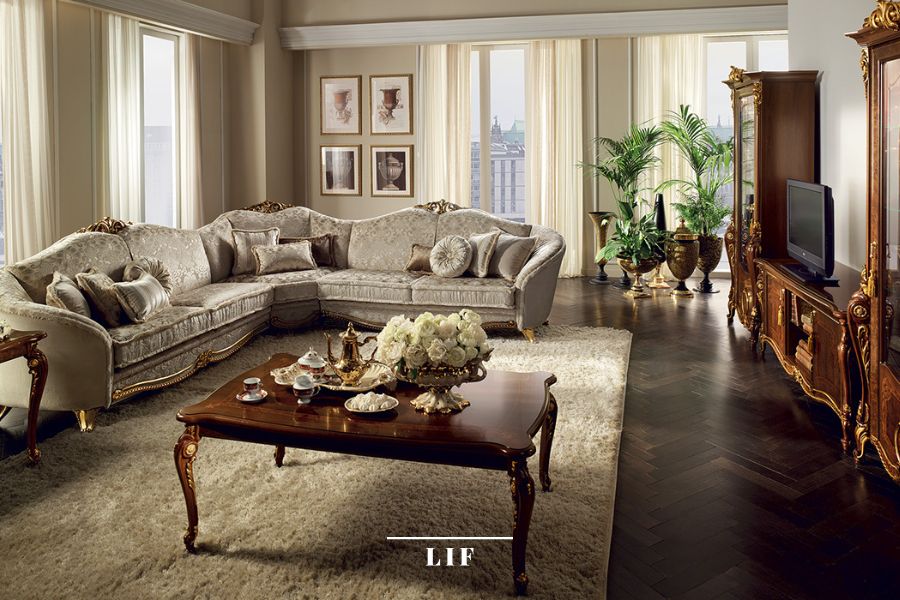
3. Neo-classical
Neo-classical style, born between 1755 and 1795 is a genuine reference to the ancient splendors of Rome and Greece. We owe the development of this style mainly to the discovery of fully furnished ancient Roman villas in Pompeii and Herculaneum.
In fact, friezes with gilt decorations and columns with elaborate designs are a frequently recurring theme in neo-classical collections.
Gold and silver embroidery is also typical of this style, as is fine detailing, interspersed with the consistency of damask velvet and precious fabrics.
Ivory, beige and walnut are the tones of furniture in neo-classical style: these furnishing elements are sometimes characterized by curved lines and other arched sections with gentler curves. Whatever the design, this style is perfect for adding an innate sense of class to your living room.
How to recognise neo-classical furniture
Neo-classical style is characterised by straight, simple lines that move away from the opulence of previous periods and towards concepts that recall the aesthetic purity of Roman and Greek times.
It is no coincidence that neo-classicism takes up some typical architectural elements of the latter, such as columns, mouldings, niches and high ceilings decorated with stuccoes, friezes and relief decorations.
There is also no lack of more rounded architectural forms, such as arches, and furniture with rich inlays. The neo-classical style is just that: a mixture of different shapes and volumes, a blend of classical and more contemporary elements.
All without ever overdoing it. The interiors maintain an underlying unpretentiousness that makes the composition harmonious and balanced: to define it in a word, a neoclassical living room is sophisticated.
Typical of this style are cupboards and large dining tables that, by combining the warm tones of walnut root with the luminous accents of gold leaf finishes and jewelled handles, create rooms that are both austere and cosy at the same time.
No less important are the complements - fine carpets, elegant chairs, ottomans, mirrors - sofas with 'fan-shaped' backrests and the lighting, which combines large, luxurious chandeliers with localised lighting points such as wall and floor lamps.
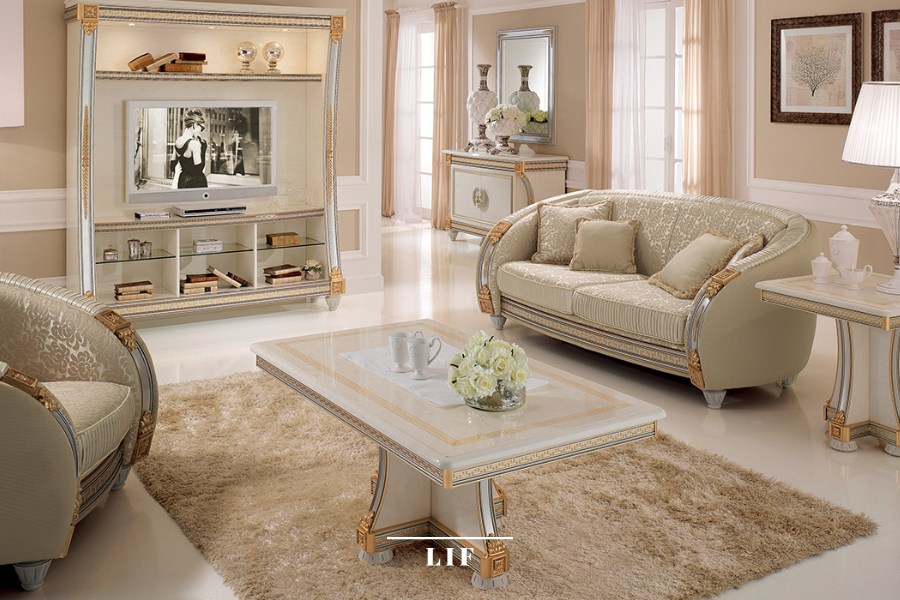
4. Empire
Empire style developed in the period of Napoleon and has become established as one of the most appreciated, popular styles in classical furnishing designs.
Considered an evolution of the Neo-classical style, of which it retains the reference to the Greek-Roman world, it is then enriched with elements inspired by the figure of the Emperor, visible above all in some of the decorations of furnishings, accessories and walls.
If you want to create a sumptuously furnished atmosphere, choose a furnishing line in Empire style with shades of walnut and elm veneer, created with materials that offer an excellent aesthetic results together with prime quality fabrics.
How to recognise Empire-style furniture
Typical of this particular design are tables that have a central foot with large, square profile, enhanced with columns and gold detailing; armchairs and sofas share the same design styles with wide seats and backs, and arms of the same height, for a balanced combination of exclusive lines and softness.
The usually restrained and homogeneous design with solid, square structures reminiscent of classicist elegance is counterbalanced by luxurious decorative elements, including capitals and finishes in bronze and marble, and elements peculiar to the style, such as furniture with 'elephant's foot' feet.
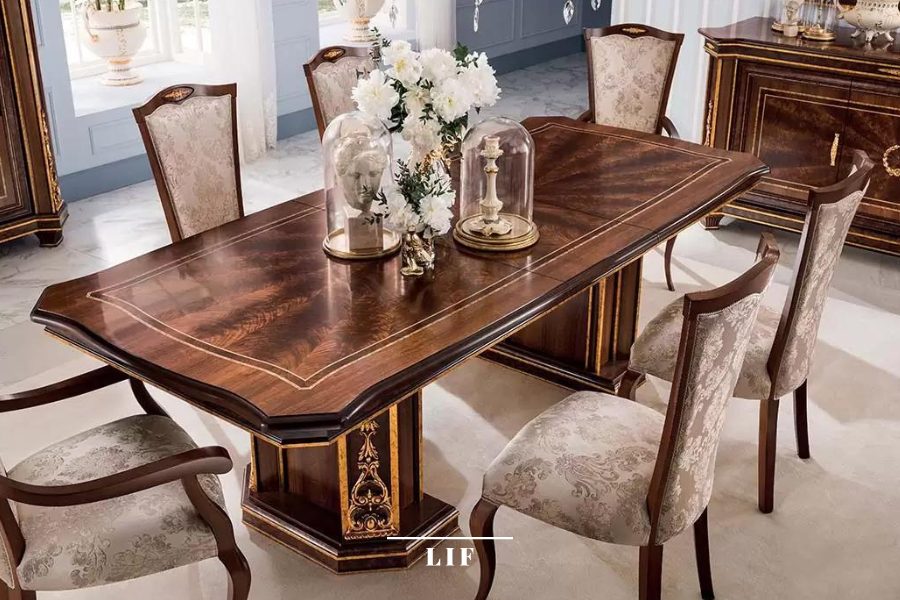
5. Chippendale
Chippendale originates from the name of the Worcester furniture maker, Thomas Chippendale, who popularized it in England between 1750 and 1780.
The English cabinetmaker devised sophisticated furniture with distinctive elements (such as pointed arches and chairs with curved backs), influencing the work of the craftsmen of the time, who gradually exported the style from England to the rest of Europe and the American colonies.
Elaborate, rich, and elegant. These are the terms that best describe this style of furnishings. Furniture in Chippendale style is the result of a perfect combination between gothic, rococo, with style influences from Chinese design.
The furnishings that best encompass the characteristics of this style are imposing wardrobes, chairs with a gothic inspiration, scallops, and inlaid tables, made in cherry, mahogany and walnut.
How to recognise Chippendale furniture
Chippendale furniture elements are famous, even today, for their robustness and quality.
One of the most characterising elements of this style is the ribbon-back seat, consisting of an arched rear and a backseat decorated with woven ribbons.
The Chinese style is recalled by the printed silk used to upholster the elements and the mahogany furniture for displaying porcelain, made with pagoda gables and openwork design. The latter can also be found in the edges of tables or on the back of chairs.
The Rococo style, on the other hand, is particularly evident in mirrors and guéridons, round tables resting on a single leg with a massive, curved shape.
The curved and elaborate lines, together with the 'S'-shapes and pointed arches, also echo traits of the Gothic style. Chippendale adds more geometric and rational elements and oriental-style furniture to them, embellished with spires, decorations and bamboo columns.
6. Biedermeier
The Viennese Biedermeier style originated in the early 19th century as a counterpoint to the pomposity of the Empire style, in favour of more understated and clean lines.
The spread of the Biedermeier movement throughout Europe was partly influenced by the advent of the industrial revolution, which promoted a new philosophy of life, based on rational models and functional products, made more in the name of comfort than aesthetics for their own sake.
In fact, Biedermeier style has a sober, essential aesthetic, compared to other trends. Unlike Empire style, for example, it has completely eliminated frills, to focus on a more linear, formal design.
The Biedermeier design introduces functional furniture made of simple, geometric lines, based mainly on the natural inlays of wood.
Michael Thonet was a leading figure in the production of Biedermeier-style furniture: it is to him that we owe the famous 'Vienna Chair', with a frame made of steam-curved solid beech wood and a seat made of Vienna straw.
How to recognise Biedermeier furniture
The shared characteristics of Biedermeier furnishings are their curves, geometric shapes and frequent use of oak, red beech and walnut, types that are recognisable from their unmistakable textures.
The décor is elegant but never ostentatious, with curves and clean lines that transform the space in a harmonious way.
For walls, wallpapers in soft pastel colours, subdued decorations and smooth surfaces are favoured.
As for cabinet-making, we still find the iconic furniture of the Empire style, such as sideboards, chests of drawers, commodes and secrétaires, but the proportions soften and the design becomes lighter and more minimal.
Comfort is the real prerogative of Biedermeier-style furniture, which is sought above all in the shapes and materials of the seats: armchairs and sofas are made with sinuous lines and soft upholstery, chairs are slightly curved and have fan-shaped seats and backs that develop in height.
Also typical of the Biedermeier style are oval or round tables with a single central leg and a solid-coloured top or with small inlays.
7. Regency
The Regency style developed in England in the first half of the 19th century as a response to the French Empire style and the German Biedermeier style.
Historically placed between Baroque and Rococo, the Regency takes the neoclassical architecture of the Georgian style as its model, emphasising the brightness and refinement of the rooms.
Regency style furniture implies the use of pieces with sculpted designs: tables with flat surfaces, chairs with slender legs, and clean lines made in mahogany and ebony with veneer in rosewood, a type of wood that offers finishes in surprising colours.
How to recognise Regency furniture
Regency-style furniture is characterised by dark woods with a high-gloss finish to create smooth, homogenous surfaces, and influences both the elegance of neoclassical furniture and the curved shapes and exotic, oriental patterns of the Chippendale style.
The Regency is also inspired by the latter for its wallpapers with floral motifs, often replacing wall decorations with stucco or paintings.
A living area furnished in this style should never forget the balance between functionality and aesthetics.
The former is achieved by adding furniture well sized in relation to the room's square footage and the use of neutral colours that favour a clean and uncluttered vision, while the latter can be expressed through decorative themes inspired by mythology or the world of flowers, with the use of bronze decorations and with the recourse to fine accessories such as cherry or walnut wood tables, candelabra and precious fabrics for curtains, carpets and upholstery.
8. Liberty
Liberty style, also known as art nouveau, dates back to the beginning of the Belle Epoque and is one of the most popular, fashionable classical styles for living room furniture.
The furniture pieces with their unmistakable curved design have a light, elegant profile, enhanced by floral decorations in bas relief.
Detached from the rigour of pure classicism, Liberty design approaches a richer and more varied stylistic form, halfway between the elegance of Art Nouveau and the opulence of the Belle Époque, without disdaining the avant-garde influences of the early 20th century and a touch of vintage that gives rooms a timeless atmosphere.
Characterising elements of the Liberty style
The furniture does not totally deviate from classical models, but acquires an identity all of its own thanks to the diversity of influences that run through it and make the composition totally unpredictable.
The Liberty style is a harmonious (and unusual) sum of curved lines and asymmetries, luxurious complements, craftsmanship and meticulous decoration, furniture rich in precious inlays ornamental details from distant places and epochs and the predominance of floral motifs and those linked to nature and the female figure.
Functionality is not neglected, but it is aesthetics that takes centre stage: the living room shines in its own light.
The glossy surfaces, the refinement of ivory, the luxury of gold finishes: every detail is an expression of harmony, royalty and beauty.
Glass, wrought iron and ceramics were also juxtaposed with lacquered woods, while for fabrics, Liberty favoured brocades, leather and velvet.
Sofas covered in premium, gold- and silver-embroidered fabrics are also the essence of liberty style and permeate each complementary item, giving the atmosphere in the living room a strong sense of luxury and class.

9. Art déco
Art Deco was born in the 1920s, immediately after the end of the World War I. The basic idea seems to reflect the common thinking of the time: leave the ugliness of war behind and enjoy life with small luxuries and seemingly futile material goods.
In the wake of this mood, a living room furnished in Art Deco style is regal and sophisticated, made with luxurious materials and elegant geometric lines, such as the Dolce Vita collection by Arredoclassic, but also creative, original, carefree.
How to recognise Art Deco furniture
An Art Deco living room reflects a new concept based on clean lines and refined finishes and material details.
Contrasts, created through the use of colours, graphic motifs and metallic details, are the hallmark of this furnishing trend.
Furniture with an elm finish, enhanced by ornamental details, straight lines and curves come together on each piece, together with fine upholstery and fabrics, used to cover sofas, daybeds, and chairs of different types.
Alongside solid surfaces and geometric shapes, curvy shapes, rounded corners, enveloping materials such as velvet, touches of eccentricity and unusual motifs such as feathers, leaves and Egyptian ornaments (sphinxes, hieroglyphics, pyramids) appear in the Art Deco style.
Refined, dusty colours, such as ivory or powder pink, mix with deeper shades, such as bottle green and midnight blue, giving the living room a strong, recognisable personality.
The fine woods of the furniture interact with the gleaming metals of the furnishings and with the other materials typical of the style, such as steel, wrought iron and matt glass.
Lighting plays an important role with rooms being enriched with lamps and wall sconces in brass, copper and bronze or gold finishes.
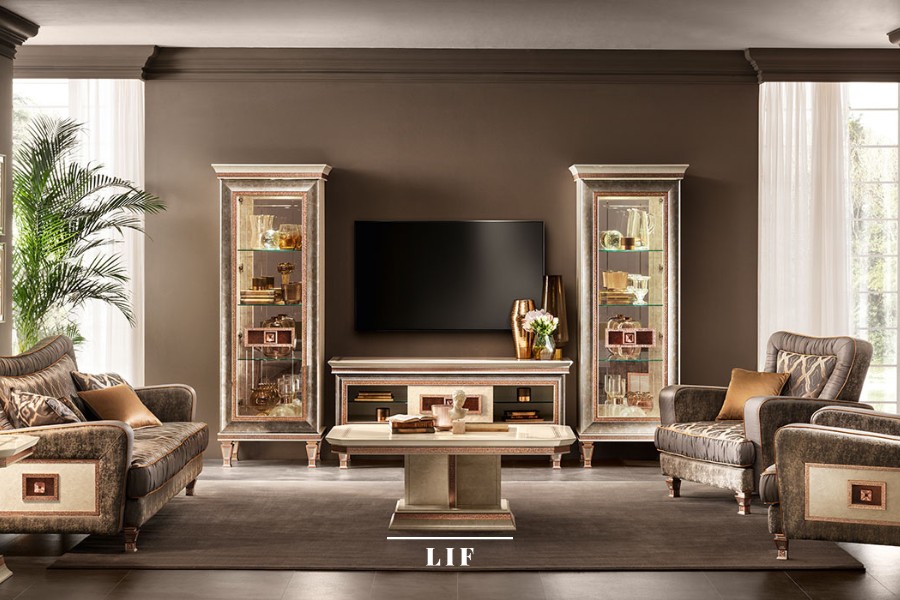
10. Colonial
Colonial furniture is a branch of the classical style, but it is also the most eclectic of the designs we've seen so far.
The reason is easy to understand. The colonial style, as the name suggests, was created by bringing together two different traditions: that of the colonial state-power and that of the colonised country. The result can only be a fascinating mixture of atmospheres and cultures.
It is also difficult to place in time, as it covers a period from 1500 to 1800, with echoes even in more recent times.
How to recognise Colonial furniture
Colonial-style furniture and furnishings have an aesthetically elegant and light profile - delicate curves and linear sections blend seamlessly into a simple and balanced design.
The materials they are made of - mainly top-quality wood - make them reliable, functional and long-lasting. Typical woods are oak, pine, walnut, cherry and toulipierwood, which is obtained from the trunks of the liriodendron tulipifera, from the central-eastern area of the United States.
Among the various colonial styles, the most widespread is undoubtedly the English colonial style.
Some of the must-have furnishings include bookcases, desks, four-poster beds, sideboards and buffet furniture.
Spaces are generally dominated by large windows (to let in as much light as possible), few architectural elements to obstruct the space and a wealth of decorations, plants, prints and objects from travels.
One of the most functional colours to recreate a colonial-style living room is yellow, so much so that there is a shade called 'colonial yellow'. Other typical nuances are the bright shades of red, blue and green, juxtaposed with black, white and various shades of wood brown.
On the walls, we find decorations ranging from British wallpapers to exotic and floral motifs, fine tapestries and elegant classically inspired woodwork.
Classic interiors: how to furnish your living room with elegance and personality
Now that you have an exhaustive overview of classic living room styles to inspire you, it is up to you to choose the one that reflects your personality and best suits your taste.
You can also choose more than one style, capturing the elements and characteristics of each that best suit the type of ambience you want to create. This way, your living room will surely be customized and unique.
Be careful, however, when combining different stylistic influences, to keep in mind the two key concepts of interior design: harmony and balance.
Equally important is to create a well-kept and elegant environment in which aesthetics and conviviality come together in a pleasant and cosy atmosphere.
Arredoclassic customer service is at your disposal to advise you on the most suitable style for you and your home.

